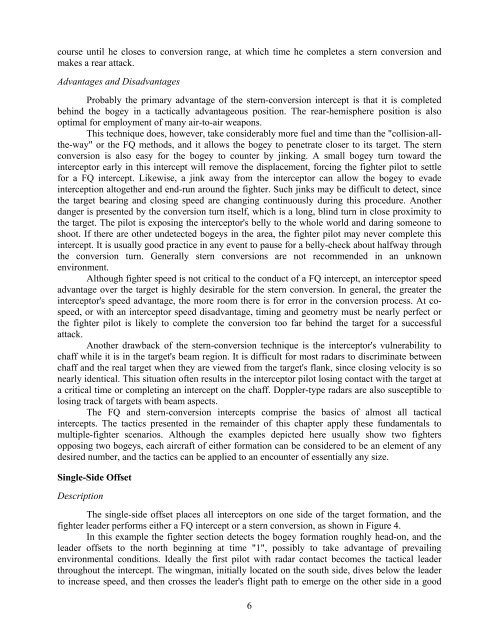Tactical Intercepts.pdf - e-HAF
Tactical Intercepts.pdf - e-HAF
Tactical Intercepts.pdf - e-HAF
You also want an ePaper? Increase the reach of your titles
YUMPU automatically turns print PDFs into web optimized ePapers that Google loves.
course until he closes to conversion range, at which time he completes a stern conversion and<br />
makes a rear attack.<br />
Advantages and Disadvantages<br />
Probably the primary advantage of the stern-conversion intercept is that it is completed<br />
behind the bogey in a tactically advantageous position. The rear-hemisphere position is also<br />
optimal for employment of many air-to-air weapons.<br />
This technique does, however, take considerably more fuel and time than the "collision-allthe-way"<br />
or the FQ methods, and it allows the bogey to penetrate closer to its target. The stern<br />
conversion is also easy for the bogey to counter by jinking. A small bogey turn toward the<br />
interceptor early in this intercept will remove the displacement, forcing the fighter pilot to settle<br />
for a FQ intercept. Likewise, a jink away from the interceptor can allow the bogey to evade<br />
interception altogether and end-run around the fighter. Such jinks may be difficult to detect, since<br />
the target bearing and closing speed are changing continuously during this procedure. Another<br />
danger is presented by the conversion turn itself, which is a long, blind turn in close proximity to<br />
the target. The pilot is exposing the interceptor's belly to the whole world and daring someone to<br />
shoot. If there are other undetected bogeys in the area, the fighter pilot may never complete this<br />
intercept. It is usually good practice in any event to pause for a belly-check about halfway through<br />
the conversion turn. Generally stern conversions are not recommended in an unknown<br />
environment.<br />
Although fighter speed is not critical to the conduct of a FQ intercept, an interceptor speed<br />
advantage over the target is highly desirable for the stern conversion. In general, the greater the<br />
interceptor's speed advantage, the more room there is for error in the conversion process. At cospeed,<br />
or with an interceptor speed disadvantage, timing and geometry must be nearly perfect or<br />
the fighter pilot is likely to complete the conversion too far behind the target for a successful<br />
attack.<br />
Another drawback of the stern-conversion technique is the interceptor's vulnerability to<br />
chaff while it is in the target's beam region. It is difficult for most radars to discriminate between<br />
chaff and the real target when they are viewed from the target's flank, since closing velocity is so<br />
nearly identical. This situation often results in the interceptor pilot losing contact with the target at<br />
a critical time or completing an intercept on the chaff. Doppler-type radars are also susceptible to<br />
losing track of targets with beam aspects.<br />
The FQ and stern-conversion intercepts comprise the basics of almost all tactical<br />
intercepts. The tactics presented in the remainder of this chapter apply these fundamentals to<br />
multiple-fighter scenarios. Although the examples depicted here usually show two fighters<br />
opposing two bogeys, each aircraft of either formation can be considered to be an element of any<br />
desired number, and the tactics can be applied to an encounter of essentially any size.<br />
Single-Side Offset<br />
Description<br />
The single-side offset places all interceptors on one side of the target formation, and the<br />
fighter leader performs either a FQ intercept or a stern conversion, as shown in Figure 4.<br />
In this example the fighter section detects the bogey formation roughly head-on, and the<br />
leader offsets to the north beginning at time "1", possibly to take advantage of prevailing<br />
environmental conditions. Ideally the first pilot with radar contact becomes the tactical leader<br />
throughout the intercept. The wingman, initially located on the south side, dives below the leader<br />
to increase speed, and then crosses the leader's flight path to emerge on the other side in a good<br />
6
















